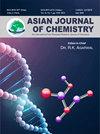Impact of Ho3+ Substitution on Structural, Morphological, Optical, Electrical, Thermoelectrical and Magnetic Properties of MgCuHoxFe2-xO4 (0 < x < 0.030) System
Q4 Chemistry
引用次数: 0
Abstract
A series of rare earth (Ho3+) doped magnesium-copper nanoferrites with the general chemical compositions of Mg0.5Cu0.5HoxFe2-xO4 (where x = 0.000, 0.005, 0.010, 0.015, 0.020, 0.025 and 0.030) was fabricated by citrate sol-gel auto-combustion technique. The fabricated materials were investigated through powder XRD, FESEM, EDX, HRTEM, FTIR, UV-Vis, DC resistivity, TEP and VSM for magnetic properties. The crystallite size of the samples was determined to be in the range of 33-40 nm with increased Ho3+ content and the powder-XRD investigations validated the spinel cubic structure of the samples with the space group Fd3m. The analysis demonstrated that the lattice constant was reduced from 8.403 to 8.356 Å and according to the FE-SEM micrographs, the morphology of the samples were found to be spherical. The HR-TEM micrographs show that average particle size decreases from 64 to 48 nm. The FTIR examination revealed that their ν1 and ν2 absorption bands were located between 412-401 cm–1 and 562-547 cm–1, respectively and the optical band gap was found to be 2.77-3.28 eV. In Mg-Cu nanoferrites with Ho doping, there was no obvious increase in the elasticity moduli. It was observed that the thermal energy required to transform the p-type Mg-Cu nanoferrites from semiconducting to n-type semiconducting behaviour increases with increasing Ho doping and composition. The M-H loop saturation magnetization (Ms), coercivity (Hc) and retentivity (Mr) values were all enhanced when the Ho3+ concentration increased and varied anisotropically with Ho doping. The findings of this study suggested that Mg-Cu ferrites doped with Ho3+ might be beneficial for magnetic resonance imaging in biomedicine.取代 Ho3+ 对 MgCuHoxFe2-xO4 (0 < x < 0.030) 体系的结构、形态、光学、电学、热电和磁学特性的影响
利用柠檬酸盐溶胶-凝胶自燃烧技术制备了一系列掺杂稀土(Ho3+)的镁铜纳米铁氧体,其一般化学成分为 Mg0.5Cu0.5HoxFe2-xO4(其中 x = 0.000、0.005、0.010、0.015、0.020、0.025 和 0.030)。通过粉末 XRD、FESEM、EDX、HRTEM、FTIR、UV-Vis、直流电阻率、TEP 和 VSM 对制备的材料进行了磁性研究。经测定,随着 Ho3+ 含量的增加,样品的晶体尺寸在 33-40 nm 之间,粉末 XRD 研究验证了样品的尖晶石立方结构,空间群为 Fd3m。分析表明,晶格常数从 8.403 Å 降低到 8.356 Å,根据 FE-SEM 显微照片,样品的形态呈球形。HR-TEM 显微照片显示,平均粒径从 64 纳米减小到 48 纳米。傅立叶变换红外光谱(FTIR)检测显示,其 ν1 和 ν2 吸收带分别位于 412-401 cm-1 和 562-547 cm-1 之间,光带隙为 2.77-3.28 eV。在掺杂了 Ho 的 Mg-Cu 纳米铁氧体中,弹性模量没有明显增加。据观察,p 型 Mg-Cu 纳米铁氧体从半导体行为转变为 n 型半导体行为所需的热能随着 Ho 掺杂量和成分的增加而增加。当 Ho3+ 浓度增加时,M-H 环饱和磁化率(Ms)、矫顽力(Hc)和保持力(Mr)值都有所提高,并且随着 Ho 掺杂量的增加而各向异性地变化。研究结果表明,掺杂了 Ho3+ 的镁铜铁氧体可能有利于生物医学中的磁共振成像。
本文章由计算机程序翻译,如有差异,请以英文原文为准。
求助全文
约1分钟内获得全文
求助全文
来源期刊

Asian Journal of Chemistry
化学-化学综合
CiteScore
0.80
自引率
0.00%
发文量
229
审稿时长
4 months
期刊介绍:
Information not localized
 求助内容:
求助内容: 应助结果提醒方式:
应助结果提醒方式:


